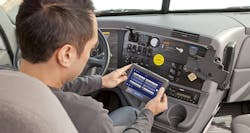As the commentary period for the Federal Motor Carrier Safety Administration’s (FMCSA) supplemental notice of proposed rulemaking regarding electronic logging devices (ELDs) begins to wind down, trade groups, industry suppliers, and others trying to analyses the potential promise and pitfalls not only of such devices but the specific regulations governing their use.
In meetings held during the 2014 Zonar Systems user conference in San Antonio, TX, last week, Fred Fakkema, the company’s VP of compliance, cautioned that as things stand right now the soonest FMCSA could issue a final rule regarding ELDs would be the spring of 2015, meaning a final adoption deadline for the devices wouldn’t be until the spring of 2017.
“Once a final rule is posted, that’s when the adoption clock starts,” he explained. “But right now there’s a huge push on to extend the comment period another 30 days past the May 18 deadline because this is just such a huge rule; it is 268 pages long.”One sticking point in current deliberations regarding ELD operation is the issue of “personal conveyance,” when a driver goes off duty but must use his or her tractor to go home, travel to overnight parking, or get something to eat.
“Right now there’s no limit on personal conveyance,” Fakkema (seen at right) said. “For example, if they drive from the terminal yard to dinner or a movie, the device will not record that as on-duty drive time – as long as they are not getting paid.” For authorized in-yard moves, such as shifting a trailer between docks, that time would be recorded as “on-duty not-driving,” he added.
However, other scenarios confuse that issue, such as if a driver uses his or her tractor to go get lunch yet gets paid for that time. “That’s one of the difficulties with this rule – it’s open to multiple interpretations,” Fakkema explained.
Another big issue regarding ELDs – one that sank FMCSA’s first attempt to mandate them three years ago – regards “driver harassment,” which Jack Van Steenburg, FMCSA’s assistant administrator and chief safety officer, revolves around preventing motor carriers from disrupting a driver’s off-duty time via the device as well as giving drivers “ownership” of the hours of service (HOS) information recoded by the devices.
“The big key to this rulemaking are the anti-harassment provisions.” Steeburg explained at the Zonar conference. “It mandates a ‘mute option’ for when the driver is in the sleeper berth, establishes a compliant process and [harassment] penalties, and gives drivers access to their own HOS records.”
Yet in an ironic twist, the proposed ELD regulations also require drivers to provide paper documentation to back up their electronic records from one of five categories: payroll data, schedules/itineraries, trip records/bills of lading, expense receipts, or communication records.
Rob Abbott, VP-safety policy for the American Trucking Associations (ATA), said many in the industry believe that documentation requirement is “too broad,” though he stressed the trade group supports the overall initiative to mandate ELDs as they will improve HOS compliance and thus safety.
Zonar’s Fakkema put it more bluntly: “Is it defeating the entire purpose of ELDs by requiring paper documentation?” he asked.
ATA’s Abbot said the trade group is also expressing concern over what he called the four-year “grandfather period” being provided within the ELD rule for carriers currently using electronic onboard recorders (EOBRs) systems.
“Is four years long enough? Can older [EOBR] devices be upgraded with simple software to comply with the new rules or will carriers need to switch over to new technology?” he asked.
Collin Mooney, deputy executive director of the Commercial Vehicle Safety Alliance (CVSA), expressed his group’s concern about the tamper resistance of current ELD technology and whether the FMCSA’s “phase in” approach allowing older EOBRs to be used alongside new ELDs could create difficulties on the enforcement end of things.
As it stands now, FMCSA’s proposed ELD rulemaking would allow fleets using “ELD-like” devices meeting current standards to keep using them until two years after the final adoption deadline for ELDs, which would be four years until after the final rule becomes effective, whenever that may be.
“But that ‘two plus two’ phase-in could create a situation where law enforcement may be reviewing three different types of HOS recording systems – EOBRs, ELDs and paper logbooks – for two years,” he said.
Then there is the ongoing debate over the technical requirements for ELDs within the rule, stressed Zonar’s Fakkema.
“FMCSA is trying to get interoperability of ELDs into the rules, with standard file formats to ease the exporting of data,” he said. “Basically, it’s trying to get all the devices to play together.”
The difficulty is not only in harmonizing electronic HOS data but also how to transfer it to law enforcement during roadside inspections. “Right now in the rule, ELDs must be capable of transferring the driver’s log electronically or by printing a paper record,” Fakkema explained.
During roadside inspections, primary electronic information transfers can occur one of three ways: by email, by wireless web service, or by Bluetooth. Two backup transfer methods must also be available; one must be law be a USB port, with the other either a scanable quick response “QR” code or by “bumping’ electronic devices together.
“And if you can’t show the logbook information in a ‘grid/graph’ format on the ELD display screen then you must print it out,” he added.
Fakkema stressed, too, that there will be information delivery issues regardless of the type of technology involved. “Take QR codes: you can only load so much data into these, so will there be enough room to fit all of the HOS information in one?” he said.
Then there are what he called the “malfunction” rules, which allow a driver to revert to paper logs in case of an ELD failure for up to seven days – though drivers can apply for a five day extension with the FMCSA. “An ELD though must be repaired and back on line in eight days under the rule,” he pointed out.
That’s why Fakkema believes the industry won’t see a final ELD rule for at least another year. “We still have all those issues to get through, plus OMB [the Office of Management and Budget] needs at least eight months to sign off on it,” he said.
About the Author
Sean Kilcarr
Editor in Chief
Sean Kilcarr is a former longtime FleetOwner senior editor who wrote for the publication from 2000 to 2018. He served as editor-in-chief from 2017 to 2018.

